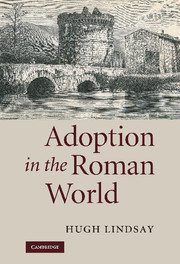Book contents
- Frontmatter
- Contents
- List of figures
- Preface
- List of abbreviations
- Introduction
- 1 Adoption, kinship and the family: cross-cultural perspectives
- 2 Kinship in Greece and Rome
- 3 Greek adoptions: comparisons and possible influences on the Roman world
- 4 Procedural aspects of Roman adoption
- 5 The testamentary adoption
- 6 Roman nomenclature after adoption
- 7 Adoption and inheritance
- 8 Roman freedmen and their families: the use of adoption
- 9 Adoption in Plautus and Terence
- 10 Sallust and the adoption of Jugurtha
- 11 Adrogatio and adoptio from Republic to Empire
- 12 Testamentary adoptions – a review of some known cases
- 13 Political adoptions in the Republic
- 14 Clodius and his adoption
- 15 The adoption of Octavian
- 16 Political adoption in the early Empire at Rome, Pompeii and Ostia; the imperial family
- Conclusion
- Glossary
- References
- Index
1 - Adoption, kinship and the family: cross-cultural perspectives
Published online by Cambridge University Press: 25 January 2010
- Frontmatter
- Contents
- List of figures
- Preface
- List of abbreviations
- Introduction
- 1 Adoption, kinship and the family: cross-cultural perspectives
- 2 Kinship in Greece and Rome
- 3 Greek adoptions: comparisons and possible influences on the Roman world
- 4 Procedural aspects of Roman adoption
- 5 The testamentary adoption
- 6 Roman nomenclature after adoption
- 7 Adoption and inheritance
- 8 Roman freedmen and their families: the use of adoption
- 9 Adoption in Plautus and Terence
- 10 Sallust and the adoption of Jugurtha
- 11 Adrogatio and adoptio from Republic to Empire
- 12 Testamentary adoptions – a review of some known cases
- 13 Political adoptions in the Republic
- 14 Clodius and his adoption
- 15 The adoption of Octavian
- 16 Political adoption in the early Empire at Rome, Pompeii and Ostia; the imperial family
- Conclusion
- Glossary
- References
- Index
Summary
A broad survey of adoption across cultural boundaries will reveal how different historical and contemporary communities have responded to the issue of introducing outsiders into their kinship network. This impressionistic account will attempt to comment on how issues of integration are handled in a wide range of contexts, under markedly different arrangements regarding kinship.
There is no attempt here to see kinship in evolutionary terms, or even to suggest direct comparability between the various communities surveyed. They have been chosen on the basis that they represent distinctive and potentially illuminating responses to particular kinship arrangements. It is hoped that this discussion will help an appreciation of how the Romans used the institution.
Other agnatic systems may superficially resemble the Roman one, at least in this strong emphasis on the perpetuation of the male line, but even communities with very strict customary procedures tend to find that factors other than mere kinship are important in selecting adoptees when their own line is in jeopardy. Rome undoubtedly fits this model. All adoptions create a fictitious proximate relationship for the purpose of inheritance of wealth, position or both. The adopter will in turn expect reciprocal obligations of some sort. These range from taking on the mantle of heir to emotional and physical support. Different communities with different social and political systems handle the details in different ways.
Once a community allows that adoption is a feasible way of bestowing social personality on the next generation, purely familial ties are potentially under threat.
- Type
- Chapter
- Information
- Adoption in the Roman World , pp. 4 - 28Publisher: Cambridge University PressPrint publication year: 2009



